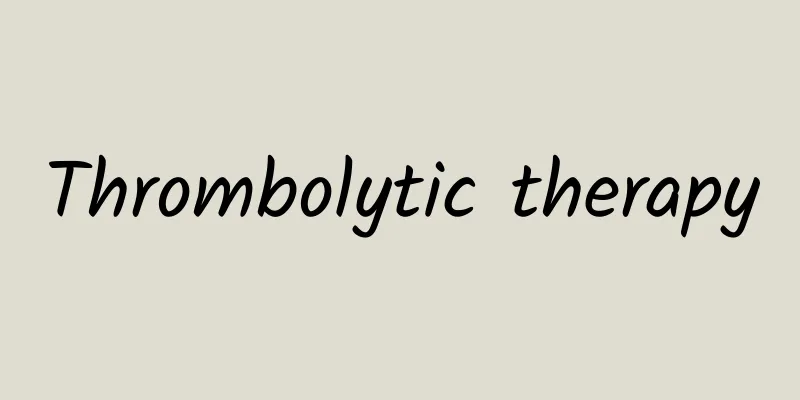Thrombolytic therapy

|
Thrombolytic therapy is a relatively common method for treating thrombosis. It refers to the use of exogenous activators to activate the endogenous system, thereby unblocking the coronary arteries, improving the patient's myocardial perfusion and avoiding myocardial involvement. It can reduce the area of infarction and improve the patient's myocardial function, thus greatly reducing the mortality rate. The main treatment method for thrombolysis is surgery, and good preparation must be made before surgery. Thrombolytic therapy 1. Preoperative preparation (i) Blood typing, blood matching, blood routine, platelet count, clotting time, prothrombin time, partial thromboplastin time, and fibrinogen determination. (ii) A temporary pacemaker can be installed when the right coronary artery is occluded, sinus bradycardia, atrioventricular block, or hypotension occurs. 2. Thrombolysis method (I) Start with intravenous or intramuscular injection of heparin 5000u, aspirin 0.3g (0.1g orally daily thereafter) and intravenous heparin 1000u, 100-200mg on the first day, so that the coagulation time is 2-2.5 times that of the control group, and FDP>normal. On the second and third days, about 100 mg of heparin was used daily to make the coagulation time 1.5 times that of the control group. (II) In recent years, foreign countries tend to use large doses of short-term streptokinase (SK) 750,000 U intravenous drip; urokinase (UK) 2 million U; 1.5 million U added to 5% glucose 20nL intravenous injection in several times, and then 5% glucose 500ml plus UK 500,000 U intravenous drip. (III) If conditions permit, blood can be drawn at 1/2, 1, 2, 3, 6, or 12 hours for relevant examinations, and the electrocardiogram can be recorded at the same time.Limited thrombolytic therapy is a major breakthrough in the treatment of myocardial infarction, but due to limited indications, it cannot be universally applied to every patient with myocardial infarction. This is also a limitation of this method. At the same time, there is still the problem of re-occlusion after thrombolysis. The re-occlusion rate within the first 24 hours after thrombolysis is about 8%, and the re-occlusion rate during hospitalization is 10~20%. The reasons may be related to the quality of the thrombolytic agent, whether the thrombolysis is sufficient, arterial contraction, etc. The current treatment plan recommended abroad is: intravenous use of rt-PA 1mg/kg in the first hour, intravenous drip of SK 150u, and intravenous push of heparin 150u/kg at the same time; intravenous heparin 1000u/hour, and adjustment after 12 hours to make the partial thromboplastin time 2~3 times normal. Maintain for 3 to 5 days, start with aspirin 160 mg/day and intravenous nitroglycerin for 3 to 5 days (mean arterial pressure drop 1.35 kPa), then add warfarin 80 mg/day and aspirin orally. This approach has the highest success rate and the lowest reocclusion rate. Some people also advocate the combination of thrombolytic therapy and PTCA. The advantages of this approach are: (1) easy expansion (if the thrombus is fresh); (2) elimination of residual stenosis; and (3) low risk of PTCA + intravenous SK. |
<<: Is superficial vein thrombosis dangerous?
>>: What causes atrial rhythm?
Recommend
Causes of sacroiliitis
Sacroiliitis is a type of osteoarthritis. Symptom...
How to detox after hysterectomy
Because of uterine fibroids or cervical cancer, a...
Radish wine recipe
Radish seed is a common Chinese medicine. Using i...
A sleeping position that paralyzed him for the rest of his life
Bones are very important to a person. In daily li...
How long can a man's sperm survive inside a woman's body?
Only when sperm and egg combine can a fertilized ...
Can I use air conditioning after medical abortion?
After a medical abortion, women must pay more att...
How to treat foot gout? Traditional Chinese medicine has methods for treatment
Gout is a relatively common joint disease. When g...
What to do if muscle tension is too high
If a child shows symptoms of high muscle tone, it...
How to enter sleep state
In our childhood, the speed of falling asleep can...
What is the TCM treatment for lower limb edema?
Edema generally refers to excessive fluid in the ...
TCM treatment of myopia and astigmatism
Astigmatism is an eye problem that many people ha...
All the reactions of taking Chinese medicine to eliminate diseases
Many people like to take Chinese medicine to slow...
Can I fill a tooth cavity that is leaking flesh?
Because people do not pay attention to protecting...
Can knee cartilage damage heal on its own?
If cartilage damage occurs in the knee, it will h...
Pyoderma gangrenosum
Pyoderma gangrenosum is a very common skin diseas...









